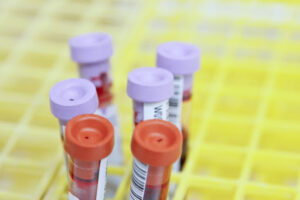Cryopreservation is widely used, especially in the medical and pharmaceutical industries. This advanced method uses cryogenic liquid gases to cool cellular material and medicines, among other things.
But what exactly is cryopreservation? What are the most common methods and applications of this technique, and how does Demaco help its clients to make cryopreservation projects flawless and safe? We will answer all these questions and more in this article.
What is cryopreservation?
Cryopreservation is a widely used method in the cryogenic industry, whereby biological material or chemical elements are preserved using cryogenic cooling. In most cases, liquid nitrogen (-196 °C) is used as the refrigerant, although this depends on the project’s scope.
Cryopreservation can refrigerate a vast array of matter. Examples include blood cells, stem cells, oocytes, embryos, plant germplasm, and certain medication forms. Often the cooling takes place in a biobank, also known as cryoroom, which is designed especially for cryopreservation in a hospital or laboratory.
Cryopreservation has certain advantages over ‘normal’ freezing. When a product is frozen in a standard freezer like the ones most people have at home, freezing is a relatively unregulated process that often results in the formation of crystals. These crystals damage the product’s cells; once defrosted, the product no longer has the same shape and condition as before. With food, this doesn’t have to be a problem; however, with biological material or medication, alterations of the product can cause serious problems.
A few of the methods used during cryopreservation aimed at best-protecting cells are the meticulous control of the freezing process (controlled-rate freezing) and adding molecules (cryoprotectants) into the cells. The latter method is mainly used to preserve biological material to minimize dehydration and prevent intracellular ice crystals.
Which agents are added depends on the material being cooled. For example, glycerol is used for the safe freezing of red blood cells, and DMSO is used for most other cells and tissues. In dry freezing methods, trehalose is widely used. This agent is predominantly effective in preventing dehydration.
Methods of cryopreservation
As briefly explained earlier, there are several methods of cryopreservation. Which of the methods works best depends on the purpose of refrigeration and the product being refrigerated.
Some well-known methods include:
Controlled-rate freezing: During controlled freezing, a closed dewar is brought to extremely low temperatures using liquid nitrogen. By carefully monitoring the cooling process, cell or other material deterioration is avoided as much as possible. Especially in the pharmaceutical and medical field, this method is popular for cooling tissue and medication.
Subzero nonfreezing storage: Subzero nonfreezing storage uses temperatures below zero to preserve materials in optimum quality without the risk of freezing which can cause deterioration. This means temperatures below 0 °C, where the material does not yet actually freeze. In particular, the research sector regularly uses this method for experiments involving the cooling of organs and, for example, stem cells.
Cryopreservation using dry ice: The use of dry ice is prevalent for, among other things, the safe storage and transportation of vaccinations. Dry ice is carbon dioxide in solid form, with a temperature of -78 °C. In addition to vaccinations, semen and stem cells are also regularly stored and transported using dry ice.

Cryopreservation and working safely
Cryopreservation is a risky process. When working with extremely cold temperatures, various health risks and risks of loss of valuable materials arise. Consider:
- Injury to the skin when it comes into contact with liquid nitrogen or dry ice.
- Quality loss of liquid nitrogen due to poor insulation of the cryogenic infrastructures.
- Formation of wet spots on the cryogenic piping when parts of it are poorly insulated. Wet spots attract bacteria, which can be particularly harmful in hospitals and laboratories.
Safety is an essential part of cryopreservation. Handling cryogenic gas or dry ice always goes hand in hand with proper protective clothing and nothing less than high-quality cryogenic systems. After all, the better the equipment, the less likely accidents or waste occurs.
Demaco’s products for cryopreservation
To perform cryopreservation projects safely and efficiently, Demaco provides the following products:
Vacuum insulated piping
In most cases, cryopreservation is accomplished in cryogenic dewars connected to a vacuum insulated piping system. Typically, outside a hospital or pharmaceutical laboratory, a tank (supplied by a gas supplier) of liquid nitrogen is positioned. A transfer line runs into the building towards the biobank. This pipe has a certain number of connection points, usually featuring a flexible section at the end of the pipe, making it easy to connect the pipe to the cryogenic dewar.

Demaco supplies high-quality rigid and flexible transfer lines, featuring vacuum insulation enhanced with a layer of glass paper and aluminum foil. This combination ensures that liquid nitrogen remains liquid even at cryogenic temperatures, thus providing safety and preventing shortfall due to gas-forming.
Oxygen Detection gauge
Quality enhancing products
On a final note: it may prove useful to add quality-enhancing products to a cryogenic infrastructure. A phase separator ensures that liquid nitrogen reaches the outlet in good quality at the right pressure. At the same time, the dewars maintain their temperature as much as possible when they are refilled. A degasser can also be used to discharge any gas formation, but can not regulate the pressure like a phase separator.
Accessory products
In the cryopreservation industry, transfer piping for liquid nitrogen is Demaco’s most sought-after product. Every year we supply cryogenic piping to dozens of biobanks in Europe. In close collaboration with our customers, Demaco also produces piping and products for other forms of cryopreservation. For example, cryogenic systems for the supply and storage of dry ice and systems intended for subzero non-freezing storage.
At Demaco, we are always happy to meet with our clients to find a solution that fits your project’s specifications.
Care to know more?
In case you have questions about cryopreservation and Demaco’s cryogenic equipment, products, and services; Do not hesitate to contact us or browse our website to check out our products and projects.




